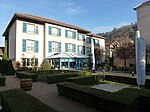Gère
Commons category link is locally definedFrance river stubsPages with French IPARivers of Auvergne-Rhône-AlpesRivers of France ... and 2 more
Rivers of IsèreTributaries of the Rhône

The Gère (French pronunciation: [ʒɛʁ]) is a 34.5-kilometre-long (21.4 mi) tributary of the Rhône in the Isère department of Auvergne-Rhône-Alpes (France). Its source is in a pond of the Grand Tuilière in the eastern part of the Bonnevaux forest. It flows into the Rhone at Vienne. Its power was put to work for paper mills, foundries, and textile mills in the Gère Valley at the beginning of the industrial era.
Excerpt from the Wikipedia article Gère (License: CC BY-SA 3.0, Authors, Images).Gère
D 502, Vienne
Geographical coordinates (GPS) Address Nearby Places Show on map
Geographical coordinates (GPS)
| Latitude | Longitude |
|---|---|
| N 45.5279 ° | E 4.8734 ° |
Address
D 502
38200 Vienne
Auvergne-Rhône-Alpes, France
Open on Google Maps






